You are here
Sew love

A young woman, armed with just her sewing machine and a van called Cecil, is travelling New Zealand with a mission to teach us how to sew.
Sarah Lancaster, the creative genius behind Sew Love, has transformed an old campervan into a mobile sewing hub. Travelling throughout the North Island, Sarah could be found camped out at an op shop near you.
She sets up for the day, offering sewing lessons to local op shoppers so they can hem items, or even use fabrics to make something completely new. If you’ve found a good item but it looks a little tired, Sarah can show you how to give it new life with some lace, beads or buttons. She can even show you how to make a tote bag using just a pillow case and a man’s tie.
So, why is she a woman on a mission? ‘It just makes so much sense,’ says Sarah, ‘Remodelling or sewing from old fabrics is cheap, it’s sustainable and by buying from op shops you’re supporting something great because your money goes to a good cause.’
Her van is fitted with solar panels to power the sewing machines, and she tries to keep textile waste to a minimum. ‘It’s all about looking around you and seeing what resources we already have, rather than bringing new things into the planet. I see op shops as resource centres.’
It was at The Salvation Army Family Store in Sarah’s hometown of Thames that her love of op shops was first ignited, and where she began her ‘crazy obsession’ with finding old sheets and fabric and transforming them into clothing.
But her greatest passion is empowering other people to re-discover the lost art of sewing for themselves. ‘People say, “Can you sew me something?”, but for the same amount of money they can learn to do it themselves.
One guy came in to get his jeans hemmed, which costs $20. But, instead I got him to sit down at the machine and taught him how to sew the hem himself. So he learnt a new skill, overcame his fear of the sewing machine, and he was just so chuffed.’
The household skill of sewing started to decline in the ’80s, when fast fashion hit mainstream New Zealand. ‘If you can buy a shirt for $10, then local industry can’t compete with that. But I ask, “What is the true cost?” How is it possible to produce a $10 shirt and fly it across the world without slave or sweatshop labour, as well as chemicals and pesticides that go into the fabric production?’
But more than anything, Sarah is simply about the joy of sewing: ‘You feel such a buzz when you’re wearing something you’ve made yourself, and I want others to feel that same pride.’
Although some op shops have been uncertain about how Sew Love will fit in with their environment, ‘by the end of the day, we’re all hugging. One person told me it was the best day they’d ever had at work’.
Meeting the diverse op shop volunteers around the country has been one of the highlights of Sarah’s road trip, she says. ‘It’s very special; they invite you for a cup of tea and tell their family history or their charity’s history. They’re very proud of their work.’
If you want to sew love for yourself, all you have to do is ‘have the courage to be unique’, says Sarah.
If you’d like a visit from Sew Love, email hello@sewlove.nz
by Ingrid Barratt (c) 'War Cry' magazine, 2 April 2016, pp3
You can read 'War Cry' at your nearest Salvation Army church or centre, or subscribe through Salvationist Resources.